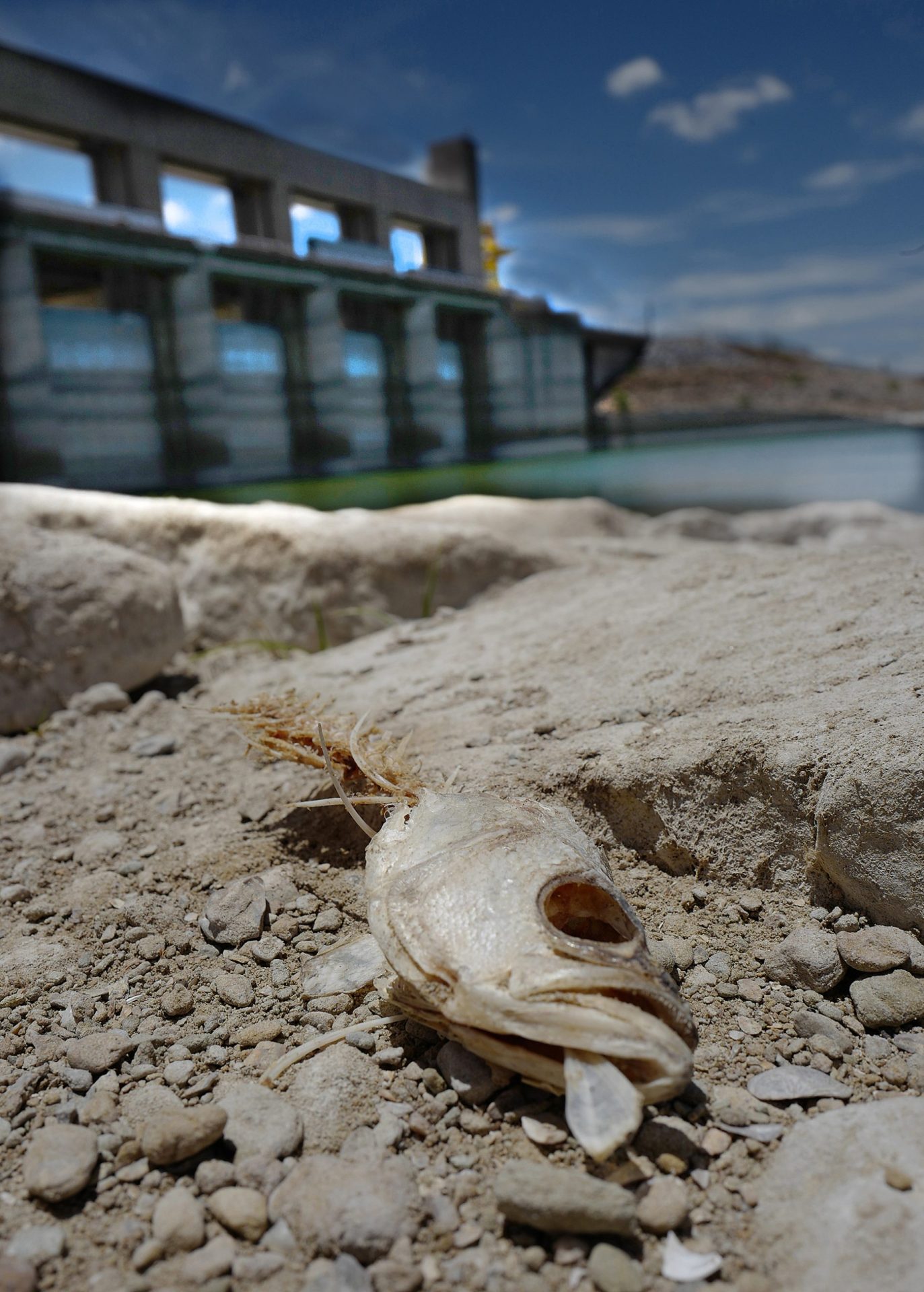FALCON HEIGHTS — An unrelenting sun glared down over a sandy beach that lay exposed near a towering wall constructed of large stones and topped by pavement.
Sun-bleached shells and a desiccated fish carcass dotted the rocky landscape where it met the gentle slope of the receding shoreline.
It was the northern foot of Falcon Dam, where water should have risen 20 feet above the head of an International Boundary and Water Commission official as he stood looking up at the structure on July 29.
Instead, the large, garage door-like steel gates that make up the dam’s spillway lay completely exposed to the air. A handful of snow-white egrets stood languidly enjoying the shade at the base of one of the gates, unaware that the very visibility of the threshold where they were perched meant water could no longer flow past.
Just a few dozen yards from the dam, a shallow island the same bleached color as the seashells rose perhaps half a foot out of the water. It hadn’t been there a week prior, the IBWC official said.
Long-range weather projections paint a pessimistic picture as the Rio Grande Valley continues to grapple with a worsening water crisis and as more municipalities began to implement drought conservation plans this week.
Meanwhile, state officials have begun to sound the alarm over Mexico’s continued noncompliance with a binational water-sharing treaty that threatens to put the region’s dwindling water supply at further risk.
WEATHER WOES
The Valley relies heavily on fresh water stored at Falcon and Amistad international reservoirs, which are currently sitting at or near the lowest level in 30 years, according to a three-month weather forecast published by National Weather Service meteorologist Barry Goldsmith on July 27.
As of Saturday, Amistad is 31.3% full, while Falcon has fallen to 9.7% full, according to Water Data for Texas.
“You can factually say, as of now, we are now combined beyond what happened in 2002 and into the 1998 (drought) benchmarks,” Goldsmith, who works out of the NWS’s Brownsville office, said on Thursday.
Not only have today’s water levels begun to rival those from decades ago, but there’s a high probability of things getting worse, especially if rains fail to materialize in September, the wettest month of the year here.
According to the three-month weather projection, forecasters expect August through October to be hotter and drier. Average temperatures have also been trending about 2 degrees higher than the 30-year average, making it more difficult to predict just how wet September will be.
But Goldsmith’s localized forecast makes it clear — September is a make-it-or-break-it month, a “wildcard.”
“The bottom line is this: if we get tropical waves, unnamed events in September — even if we get like one per week, or one per four days — that will really help out the Valley… but it will not make that much of a difference for the reservoirs,” Goldsmith said.

Goldsmith explained that mild tropical weather events that bring rainfall directly over the Valley will help bust localized drought conditions in the immediate term. However, unless a significant amount of rain falls over the Sierra Madre mountains in Mexico — where much of the Rio Grande Basin lies — then our current water scarcity issues will persist or worsen.
The meteorologist said it would take a “prodigious” amount of rain over the mountains — amounts not seen since the remnants of Hurricane Alex parked themselves over Coahuila and Nuevo Leon in 2010.
“You really need to be pushing 20, 30, 40, 50, 70 inches of rain in a month,” Goldsmith said.
“On top of all that, you have to trust that Mexico — that the water will flow freely from both the fill-and-spill reservoirs, and, if necessary, be released out of the Mexican reservoirs,” he added.
But therein lies another major factor straining U.S. water availability.
TREATY CONCERNS
Some 70% of water that flows into the Rio Grande south of El Paso comes from six tributaries on the Mexican side of the border.
Mexico is obligated by a 1944 binational treaty to deliver some 1.5 million acre-feet of water to the United States over the course of a five-year cycle, or about 350,000 acre-feet of water per year.
However, the same drought that has been afflicting the Valley, Texas and much of the American Southwest at large has also been wreaking havoc across northern Mexico.

As a result, Mexico has been consistently late in meeting its water delivery obligations. Mexico ended the 2010-2015 cycle in a deficit and came perilously close to defaulting again in October 2020.
Nearly two years into the current cycle, Mexico has once again fallen far behind — so much so that TCEQ Commissioner Bobby Janecka last week addressed a letter to the IBWC with an urgent entreaty to address the issue.
As of July 2, Mexico has accrued a deficit of just over 521,000 acre-feet, delivering less than 12% — or 68,000 acre-feet — of the water it has owed the U.S. over the last two years, Janecka stated in the letter.
The commissioner further stated he fears Mexico will continue its noncompliance with the treaty, especially after remarks made in a joint policy meeting with American and Mexican officials on May 12.
After that meeting, U.S. officials concluded that, “Mexico will not comply with its treaty obligations, even if weather patterns change and a semi-wet pattern prevails for the duration of the treaty cycle,” and that “there is no Mexican water available in Amistad or Falcon reservoirs for treaty deliveries,” Janecka stated.
“Mexico’s strategies have resulted in water shortages in Texas — and Texas cannot continue to bear the impacts from these strategies,” Janecka stated, imploring IBWC Commissioner Maria-Elena Giner to urge her Mexican counterparts to make good on the deliveries.
The plummeting reservoir levels have already forced the Rio Grande Watermaster to cut down on water allocations to agricultural water rights holders. And if levels continue to fall, it will force the watermaster to “cut the amount of water in irrigation user accounts,” Janecka said.
CAMERON COUNTY
Local officials are already feeling the impact.
Scott Fry, general manager of Valley Municipal Utility District No. 2, which supplies water to Rancho Viejo and a small portion of Brownsville, described how the district has been searching out additional sources of water to purchase.
MUD No. 2 has about 6,000 acre-feet in water rights — about 5,200 acre-feet for ag use, and another 800 acre-feet to meet municipal needs.
“We’ve been able to contract for water for some ag rights and we’ve been able to contract for some municipal rights, but it’s getting tighter and tighter,” Fry said.
“We hope that these rights that we’ve been able to contract for will get us through September, which is the rainiest period of the year for us,” he said.

Though MUD No. 2 has been able to buy some water, most water rights holders have been hanging onto what water they have, Fry said.
What has been the saving grace for MUD No. 2 has been its capacity to draw upon groundwater to meet demand. The district has a reverse osmosis plant onsite that can desalinate brackish groundwater.
The district also holds a 2.5% ownership stake in a regional water group called the Southmost Regional Water Authority.
The SRWA was established in response to the severe droughts of the late 1990s in order to reduce reliance on surface water from the Rio Grande. SWRA’s groundwater plants can produce some 8 million gallons daily, with the potential of upscaling to 20 million gallons daily, Fry said.
The SWRA’s desalination plant was among the first in the state, and it remains a rarity. Few other Valley water suppliers currently have the capability to pull groundwater and treat its salinity.
DROUGHT AND FLOOD
Until more suppliers develop that capacity, the region will remain heavily reliant on the feast-or-famine waters of the Rio Grande.
“There is a longtime proverb,” Goldsmith, the meteorologist, said describes the nature of Valley water.
“Texas is a state of perpetual drought broken by the occasional devastating flood,” he said.
It’s an axiom that has guided the region’s water storage plans thus far — Falcon reservoir, especially, was built to hold onto rainfall dropped during hurricane season.
But that weather picture has begun to change. Warming has been accelerating over the last 12 years, Goldsmith said. And average temperatures over the next three months are expected to be 1-2 degrees higher than the 30-year average from 1991-2021.
If a “reasonable” worst-case scenario occurs where September results in insufficient rainfall over the Rio Grande Basin, Goldsmith fears it could result in the kinds of crises already being seen across the border in cities like Monterrey — especially if long-term climate models that predict continued dryness through early next year prove true.
“There’s no question in my mind that if that happens, we’re going to have shut offs across large parts of the Valley and we’ll be in water crisis mode,” Goldsmith said.
“A lot of things have to happen to make that the reality, but we’re now in the range that is over the horizon,” he said.
Sonny Hinojosa, general manager of the San Juan-based Hidalgo County Irrigation District No. 2, has observed the Valley’s proverb-inspiring history of “perpetual drought” and “devastating flood” for more than 30 years. He was far more circumspect.
“We’ve been here before. We’re gonna amble along,” Hinojosa said.
“The way I look at it is you can’t make it rain. You just manage what you have. … There will be relief, we just don’t know when.”
RELATED READING:
Squeezed dry: South Texas farmers face a possible future without water




